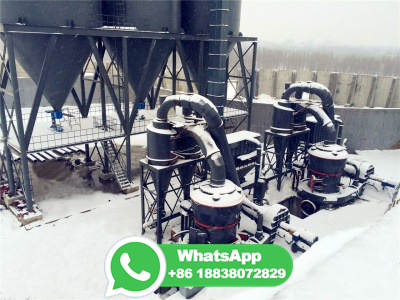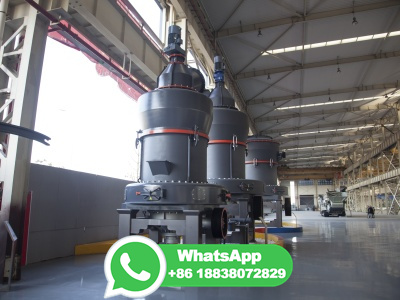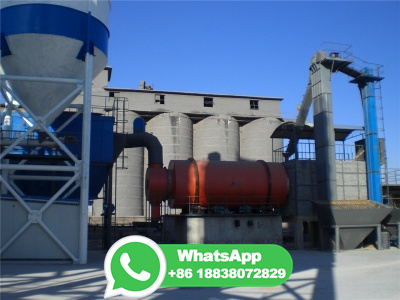
WEBLeveraging cutting edge technology, aluminium making process is continually refined to maintain high standards of quality and efficiency, and production expertise has been honed into a fine craft over the years. ... 2 ALUMINA REFINING. Bauxite is transported to processing plants where the clay is washed off and bauxite passed through a grinder ...
WhatsApp: +86 18203695377
WEBApr 19, 2024 · Aluminium can be extracted (uneconomically) from some clays but the most common aluminium ore is a material called bauxite. First the aluminium ore needs to be mined, then the bauxite is refined into alumina (aluminium oxide). ... Alumina is turned into aluminium through a smelting process. All commercial production of aluminium is .
WhatsApp: +86 18203695377
WEBDec 19, 2023 · In most commercial operations, alumina is extracted (refined) from bauxite by a wet chemical caustic leach process known as the Bayer process. The alumina is then smelted using the energyintensive HallHeroult process to produce aluminium metal by electrolytic reduction in a molten bath of natural or synthetic cryolite (NaAlF 6). .
WhatsApp: +86 18203695377
WEBJan 23, 2022 · The Bayer Process was patented in 1888 in Germany by the Austrian chemist, Karl Joseph Bayer [].The simple chemistry of the process is that the hydrated forms of aluminum in bauxite, readily dissolve in heated caustic (NaOH) solutions (the DIGESTION step, see Chap. 4).The advantage is that nearly all of the minerals in .
WhatsApp: +86 18203695377
WEBThe industrial processes required to convert bauxite ore into alumina requires consumption of significant energy to provide the heat and steam necessary for the refining process. The majority of the energy AWAC's uses is generated by natural gas, resulting in the emission of Greenhouse Gases (GHG).
WhatsApp: +86 18203695377
WEBMined bauxite ore is refined into alumina through what is known as the Bayer process. The process, discovered in 1887, extracts alumina from bauxite through crushing, dissolving it in caustic soda, filtration and an electrolytic process. Alumina is a white powder, appearing similar to table salt, which can then be smelted into aluminium metal.
WhatsApp: +86 18203695377
WEBJan 1, 2016 · The Bayer process for alumina production generates more than 160 million tons of bauxite residue annually. The current global stockpiles of bauxite residue have reached more than 4 billion tons ...
WhatsApp: +86 18203695377
WEBAluminum production in the is increasingly a story of scrap recovery and recycling. While primary aluminum production remains a vital part of the American aluminum supply chain, more than 80% of production today is in making recycled (or secondary) aluminum. This compares to 20% to 30% recycled production in the 1980s.
WhatsApp: +86 18203695377
WEBMar 13, 2023 · Primary aluminum production consists of a multistage process: Bauxite mining; Alumina Refining: transforms bauxite that is dug out of the ground into first alumina (aluminum oxide) through crushing, washing, treating, and baking the bauxite (the Bayer process), ... generating emissions throughout the whole supply chain from .
WhatsApp: +86 18203695377
WEBFour tons of bauxite produce one ton of aluminum—enough to make the cans for more than 60,000 soft drinks. Bauxite is formed over millions of years by chemical weathering of rocks containing aluminum silies, producing an ore rich in aluminum oxide. Today, bauxite is mined primarily in Africa, Australia and the Caribbean. Step 2: Refining ...
WhatsApp: +86 18203695377
WEBAluminum processing Smelting, Refining, Alloying: Although there are several methods of producing aluminum, only one is used commercially. The Deville process, which involves direct reaction of metallic sodium with aluminum chloride, was the basis of aluminum production in the late 19th century, but it has been abandoned in favour of .
WhatsApp: +86 18203695377
WEBRed mud near Stade Bauxite, an aluminium ore (Hérault department, France).The reddish colour is due to iron oxides that make up the main part of the red mud.. Red mud, now more frequently termed bauxite residue, is an industrial waste generated during the processing of bauxite into alumina using the Bayer is composed of various .
WhatsApp: +86 18203695377
WEBIn an alumina refinery bauxite is processed into pure aluminium oxide (alumina, or Al 2 O 3), which is the main raw material required for production of primary aluminium. The Bayer process extracts alumina by caustic digestion of crushed bauxite at high temperature and pressure in an autoclave, followed by clarifiion, precipitation, washing ...
WhatsApp: +86 18203695377
WEBJun 30, 2023 · As the minerals are weathered they gradually breakdown into various forms of hydrated aluminum oxide, Al 2 O 3 .xH 2 O, known as bauxite. The bauxite is purified by the Bayer Process. First the ore is mixed with a hot concentrated solution of sodium hydroxide. The NaOH will dissolve the oxides of aluminum and silicon but not other .
WhatsApp: +86 18203695377
WEBStep 3: Build modular! Each module consists of 3 Sloppy Alumina refineries and 4 Electrode Scrap refineries, and processes 600 Bauxite and 240 Petcoke into two belts of 600 Scrap. Additionally you will need to pipe in 180 water per module. To further simplify things, build the modules in pairs, for an input of 2x600 Bauxite, 1x480 Petcoke and ...
WhatsApp: +86 18203695377
WEBFirst discovered near Les Beaux in the South of France in 1821, bauxite was initially called "beauxite". In 1886, Charles Martin Hall and Paul Héroult independently developed a process for making aluminium from alumina. And in 1887, Austrian scientist Karl Josef Bayer patented his selftitled process for extracting alumina from bauxite.
WhatsApp: +86 18203695377
WEBBauxite is the basic raw material that is refined into alumina, which in turn is sent to smelters for processing into aluminium. First discovered near Les Beaux in the South of France in 1821, bauxite was initially called "beauxite". In 1886, Charles Martin Hall and Paul Héroult independently developed a process for making aluminium from ...
WhatsApp: +86 18203695377
WEBFeb 25, 2022 · In this process, aluminium compounds of bauxite ore are dissolved in hot sodium oxide solution at 150–200 °C. Bauxite is a naturally occurring sedimentary rock which is the principal source for industrially produced aluminium. In addition to different aluminium hydroxide minerals, it may contain appreciable amounts of silica, iron oxide ...
WhatsApp: +86 18203695377
WEBThe document analyzes the processes of extraction and conversion of bauxite into aluminium and provides the composition of this material.
WhatsApp: +86 18203695377
WEBApr 1, 2023 · The amount of red mud produced by an alumina refinery depended primarily on the bauxite types and alumina extraction process. The production rates of red mud were generally expressed in the tons of dry slag per ton of alumina produced and ranged from to [50], [51]. Global annual red mud emissions exceeded 150 million tons in .
WhatsApp: +86 18203695377
WEBDec 15, 2020 · Alumina production: Bayer process: calcination . Alumina is produced from bauxite in the wellestablished Bayer process, followed by a calcination process. This Bayer process was invented in 1888 by Carl Josef Bayer and contributed with the development of aluminium to the ongoing industrial revolution. The Bayer process .
WhatsApp: +86 18203695377
WEBOct 31, 2019 · From Bauxite. This manufacturing process is the most commonly used as bauxite is a ubiquitous material. It involves reacting liquid sulfuric acid with either bauxite ore containing aluminum hydroxide (Al(OH) 3) and hydrated aluminum (Al 2 O 3 ∙ 3H 2 O), or synthetic hydrated aluminum previously refined from bauxite. Bauxite ore is the .
WhatsApp: +86 18203695377
WEBJan 29, 2020 · In most commercial operations, as in Suriname's refinery at Paranam, alumina is refined from bauxite by a wet chemical caustic leach process, known as the Bayer process. Alumina is then smelted, using energyintensive electrolytic reduction, to produce aluminium, which process took place in Suriname in the previous century, .
WhatsApp: +86 18203695377
WEBHistory of aluminium. Extrusion billets of aluminium in Yugoslavia, 1968. Aluminium (or aluminum) metal is very rare in native form, and the process to refine it from ores is complex, so for most of human history it was unknown. However, the compound alum has been known since the 5th century BCE and was used extensively by the ancients for .
WhatsApp: +86 18203695377
WEBApr 20, 2022 · During the digestion process of the Bayer method, lithium and gallium in bauxite will enter into the sodium aluminate solution (Tang et al. 2020; Xu et al. 2018), which will return to the digestion process for recycling after the precipitation of aluminum hydroxide from the decomposition of crystal to a large amount of red mud .
WhatsApp: +86 18203695377